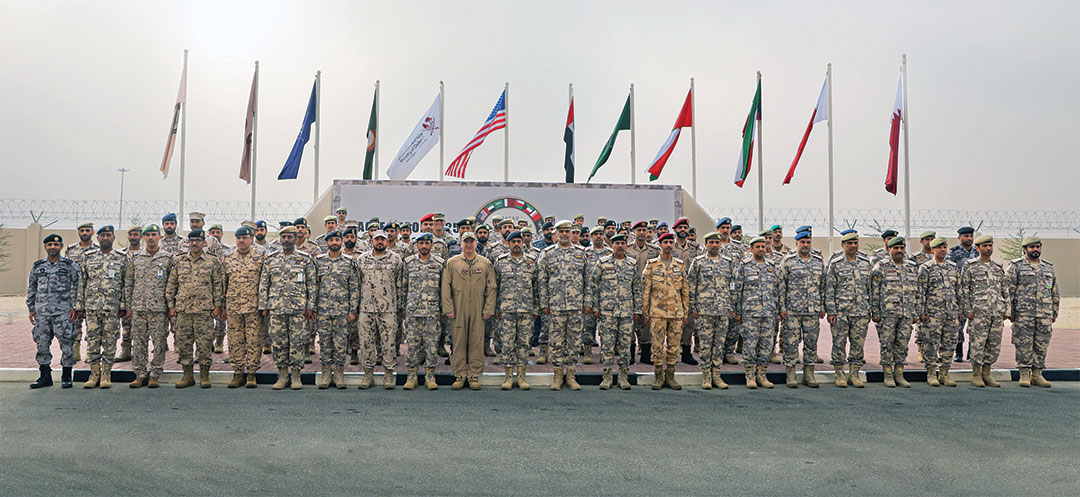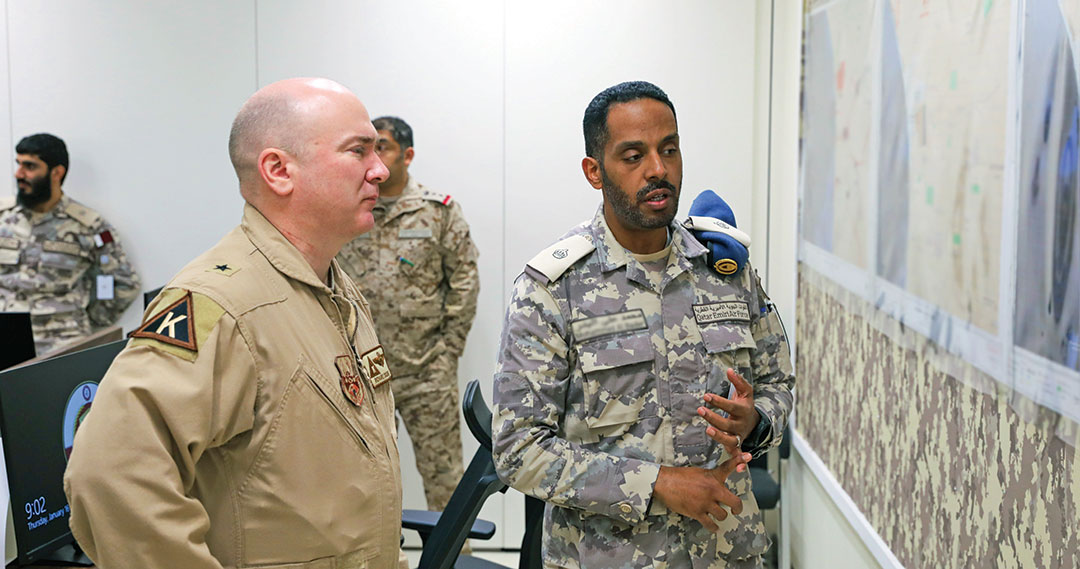What began as a diplomatic dispute over possession of underwater gas reserves erupted into air, land and maritime assaults against an innocent country.
But that country didn’t have to confront the swarm of drones, the barrage of missiles and the armed cross-border incursions solely with its own resources.
In a collective action that called on the military strength of regional partners, the country repulsed and deflected the attacks through the combined efforts of multinational forces.
Eagle Resolve 25, a military exercise hosted by Qatar in January 2025 to strengthen collective defense in Gulf Cooperation Council (GCC) countries, was a demonstration of how regional militaries can improve interoperability to defuse potential crises.
Qatar accommodated Eagle Resolve at bases in and around Doha with participation by the United States and GCC partners Bahrain, Kuwait, Oman, Saudi Arabia and the United Arab Emirates. More than 300 troops from all service branches attended the command post exercise.

and the United States pose for a group photo at Eagle Resolve. SGT. MEBEA DEMELASH/U.S. ARMY CENTRAL
“This exercise represents cooperation between Qatar and GCC countries based on deeply rooted, historic relationships between the GCC countries as well as our friend and partner the United States,” said Qatari Armed Forces Staff Brig. Gen. Hamad H. Al-Nabet, director of Eagle Resolve 25.
“The events operate under one banner to achieve stability and security in the region.”
Eagle Resolve occurs every two years, and training has increasingly focused on integrated air and missile defense that helps nations react collectively to aerial threats. If one country’s radar system begins tracking a potential attack, it can warn partners to activate their airspace defenses.
Training also familiarized troops with countering unmanned aerial systems and defending against chemical, biological, radiological and nuclear threats.
At Eagle Resolve 25, multinational forces, identifiable by their plethora of uniforms and military patches, staffed screens and computers in an air operations room. A voice rises above the chatter: “Missile launch!”
It’s part of the fictional training scenario. The room falls silent as troops from many countries refocus attention on approaching electronic blips on radar displays. News speeds along communications channels to alert defense forces, including Patriot missile batteries.

“It’s great to see how this is all coming together,” said U.S. Air Force Brig. Gen. Richard Dickens, Joint Task Force deputy commander, as he observed the training. “Everyone is working shoulder to shoulder.”
The training audience at Eagle Resolve 25 occupied four geographically dispersed sites to mimic the real world, including separate command centers for the Army, Navy and Air Force.
The head of the Kuwait Armed Forces contingent highlighted the opportunity to participate in exercises that nurture joint cooperation.
“We used modern technologies and scenarios that simulate current threats in the region, particularly the threat of drones and ballistic missiles and methods of combating them,” he said. “It is no secret that confronting this type of threat requires regional and international cooperation. That is why we consider Eagle Resolve to be one of the most important exercises through which countries in the region consolidate military concepts and learn to operate within a unified air and missile defense system.”
At a Cyber Security Training Center, students learned to identify and block enemy attempts at infiltration of command and control computer systems. They were asked to share what they learned with their units upon return to their countries, recognizing that the cyber field is always fluctuating.
“If any Soldier says, ‘I learned everything about cyber,’ don’t believe him,” one Saudi officer at the center said. “You never stop learning.”
In past iterations of Eagle Resolve held in countries across the region, the U.S. provided most of the scenarios and equipment for the exercises. In 2025, the Qataris developed the training objectives for all services and devised scenarios to support them. They were tailored to the terrain and geopolitical realities of the Middle East.
“The Qataris were pretty much running the whole show,” one U.S. officer noted.
Brig. Gen. Al-Nabet stressed the need for adequate classroom preparation before troops engage in complicated command post exercises like Eagle Resolve.

Qatar hosted several days of academic instruction before launching the actual training events. Lectures covered topics such as integrated air and missile defense, information operations, and the joint operations planning process.
“Without the training and the academic time, they are not going to be able to understand what they are trying to accomplish,” he said of the multinational training audience.
“I am against the theory of separating the academic from real-world training or real-world situations. Academic training is an important and primary part of the exercise itself. If you cannot unify planning and theory before starting the exercise, you are going to fail to work together collectively in the actual exercise.”
Military planners observed training in action to fine-tune scenarios for future Eagle Resolves. At Eagle Resolve 25, for example, friendly forces had 120 aircraft at their disposal in the fictional scenarios. A senior officer visiting the air operations center suggested grounding some of the aircraft for maintenance, equipment malfunctions being a routine part of actual military operations.
By incapacitating some of the aircraft, scenarios would offer a greater sense of realism, so that training audiences would “feel more pain” and seek ways to work around any aircraft shortage, the officer said.
GCC officers commanded most of the Eagle Resolve training cells — divided into intelligence, operations, planning and other functions — sometimes with U.S. officers serving as deputies.
The Bahrain Defense Force expressed an eagerness to participate in joint military exercises to build experience working in a multilateral joint forces environment. Eagle Resolve helps iron out national differences in military culture to create a stronger force familiar with unified concepts and tactics.
“The State of Qatar is hosting an important event for countries in the region that face common threats that are difficult to confront individually,” the colonel who led the Bahraini delegation said. “Therefore we must work to unify efforts for security, regional stability and international peace.”
Eagle Resolve has engaged regional forces since 1999 and represents an enduring U.S. commitment to encourage cooperation among friendly forces in the Middle East.
“Exercises like Eagle Resolve allow us to reinforce U.S. and Qatari cooperation while also bolstering the collective defense capabilities of Gulf Cooperation Council partners, contributing to a safer and more stable region,” said retired Gen. Michael Kurilla, then commander of U.S. Central Command.

